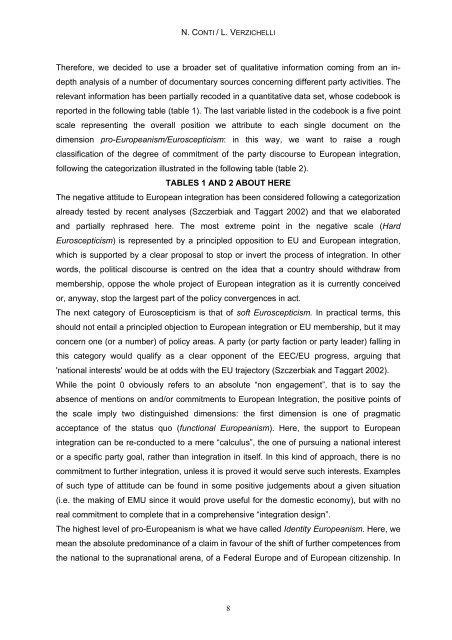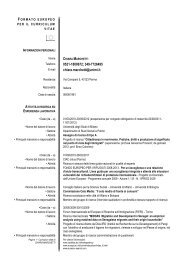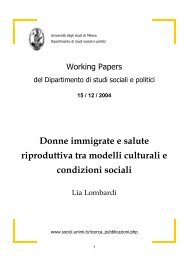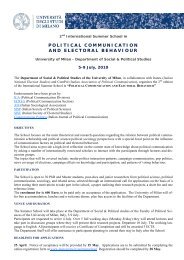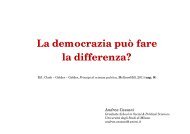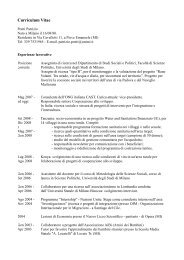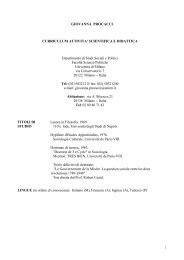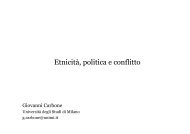The european dimension of political discourse in Italy. A ... - CIRCaP
The european dimension of political discourse in Italy. A ... - CIRCaP
The european dimension of political discourse in Italy. A ... - CIRCaP
Create successful ePaper yourself
Turn your PDF publications into a flip-book with our unique Google optimized e-Paper software.
N. CONTI / L. VERZICHELLI<br />
<strong>The</strong>refore, we decided to use a broader set <strong>of</strong> qualitative <strong>in</strong>formation com<strong>in</strong>g from an <strong>in</strong>depth<br />
analysis <strong>of</strong> a number <strong>of</strong> documentary sources concern<strong>in</strong>g different party activities. <strong>The</strong><br />
relevant <strong>in</strong>formation has been partially recoded <strong>in</strong> a quantitative data set, whose codebook is<br />
reported <strong>in</strong> the follow<strong>in</strong>g table (table 1). <strong>The</strong> last variable listed <strong>in</strong> the codebook is a five po<strong>in</strong>t<br />
scale represent<strong>in</strong>g the overall position we attribute to each s<strong>in</strong>gle document on the<br />
<strong>dimension</strong> pro-Europeanism/Euroscepticism: <strong>in</strong> this way, we want to raise a rough<br />
classification <strong>of</strong> the degree <strong>of</strong> commitment <strong>of</strong> the party <strong>discourse</strong> to European <strong>in</strong>tegration,<br />
follow<strong>in</strong>g the categorization illustrated <strong>in</strong> the follow<strong>in</strong>g table (table 2).<br />
TABLES 1 AND 2 ABOUT HERE<br />
<strong>The</strong> negative attitude to European <strong>in</strong>tegration has been considered follow<strong>in</strong>g a categorization<br />
already tested by recent analyses (Szczerbiak and Taggart 2002) and that we elaborated<br />
and partially rephrased here. <strong>The</strong> most extreme po<strong>in</strong>t <strong>in</strong> the negative scale (Hard<br />
Euroscepticism) is represented by a pr<strong>in</strong>cipled opposition to EU and European <strong>in</strong>tegration,<br />
which is supported by a clear proposal to stop or <strong>in</strong>vert the process <strong>of</strong> <strong>in</strong>tegration. In other<br />
words, the <strong>political</strong> <strong>discourse</strong> is centred on the idea that a country should withdraw from<br />
membership, oppose the whole project <strong>of</strong> European <strong>in</strong>tegration as it is currently conceived<br />
or, anyway, stop the largest part <strong>of</strong> the policy convergences <strong>in</strong> act.<br />
<strong>The</strong> next category <strong>of</strong> Euroscepticism is that <strong>of</strong> s<strong>of</strong>t Euroscepticism. In practical terms, this<br />
should not entail a pr<strong>in</strong>cipled objection to European <strong>in</strong>tegration or EU membership, but it may<br />
concern one (or a number) <strong>of</strong> policy areas. A party (or party faction or party leader) fall<strong>in</strong>g <strong>in</strong><br />
this category would qualify as a clear opponent <strong>of</strong> the EEC/EU progress, argu<strong>in</strong>g that<br />
'national <strong>in</strong>terests' would be at odds with the EU trajectory (Szczerbiak and Taggart 2002).<br />
While the po<strong>in</strong>t 0 obviously refers to an absolute “non engagement”, that is to say the<br />
absence <strong>of</strong> mentions on and/or commitments to European Integration, the positive po<strong>in</strong>ts <strong>of</strong><br />
the scale imply two dist<strong>in</strong>guished <strong>dimension</strong>s: the first <strong>dimension</strong> is one <strong>of</strong> pragmatic<br />
acceptance <strong>of</strong> the status quo (functional Europeanism). Here, the support to European<br />
<strong>in</strong>tegration can be re-conducted to a mere “calculus”, the one <strong>of</strong> pursu<strong>in</strong>g a national <strong>in</strong>terest<br />
or a specific party goal, rather than <strong>in</strong>tegration <strong>in</strong> itself. In this k<strong>in</strong>d <strong>of</strong> approach, there is no<br />
commitment to further <strong>in</strong>tegration, unless it is proved it would serve such <strong>in</strong>terests. Examples<br />
<strong>of</strong> such type <strong>of</strong> attitude can be found <strong>in</strong> some positive judgements about a given situation<br />
(i.e. the mak<strong>in</strong>g <strong>of</strong> EMU s<strong>in</strong>ce it would prove useful for the domestic economy), but with no<br />
real commitment to complete that <strong>in</strong> a comprehensive “<strong>in</strong>tegration design”.<br />
<strong>The</strong> highest level <strong>of</strong> pro-Europeanism is what we have called Identity Europeanism. Here, we<br />
mean the absolute predom<strong>in</strong>ance <strong>of</strong> a claim <strong>in</strong> favour <strong>of</strong> the shift <strong>of</strong> further competences from<br />
the national to the supranational arena, <strong>of</strong> a Federal Europe and <strong>of</strong> European citizenship. In<br />
8


